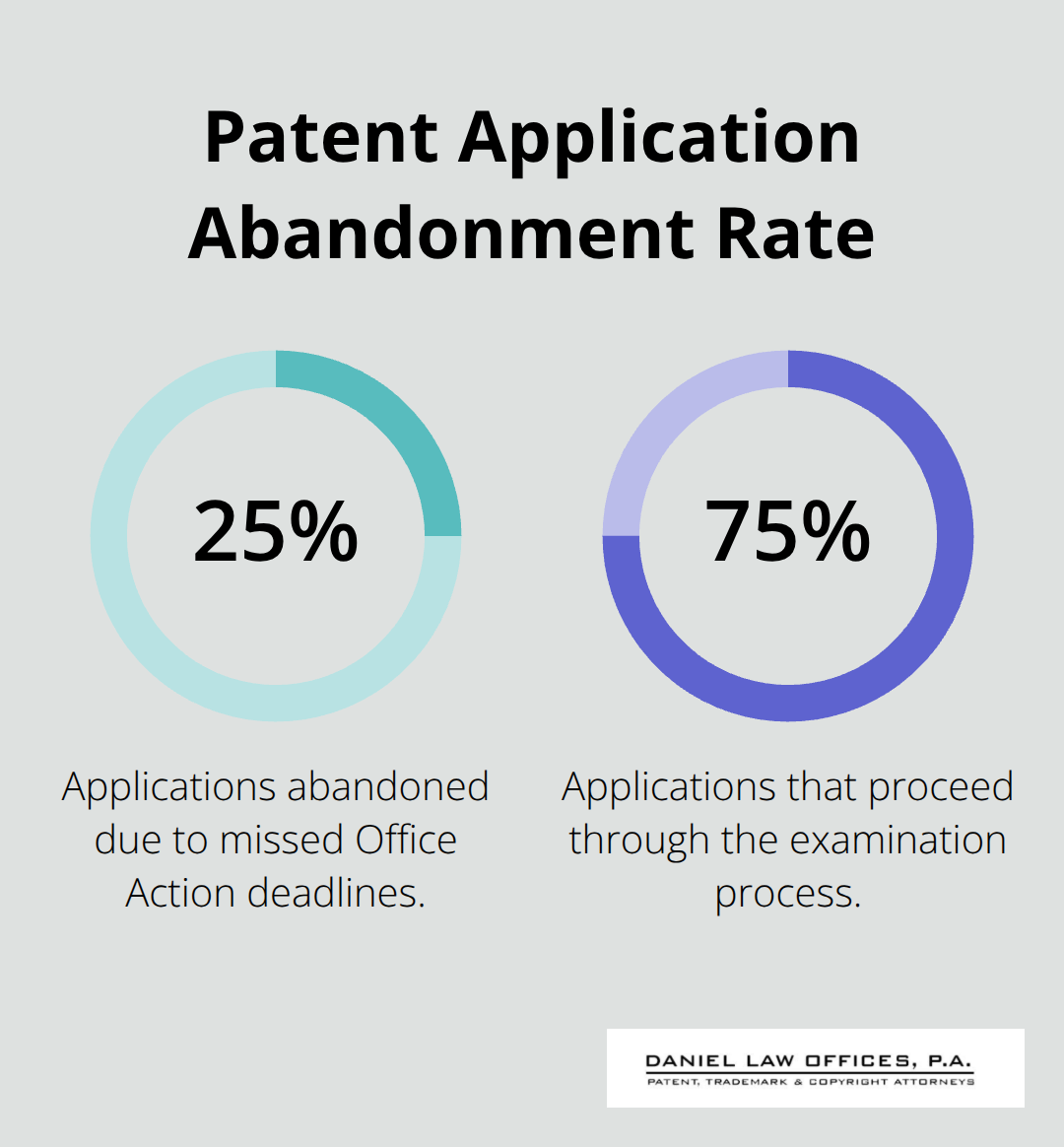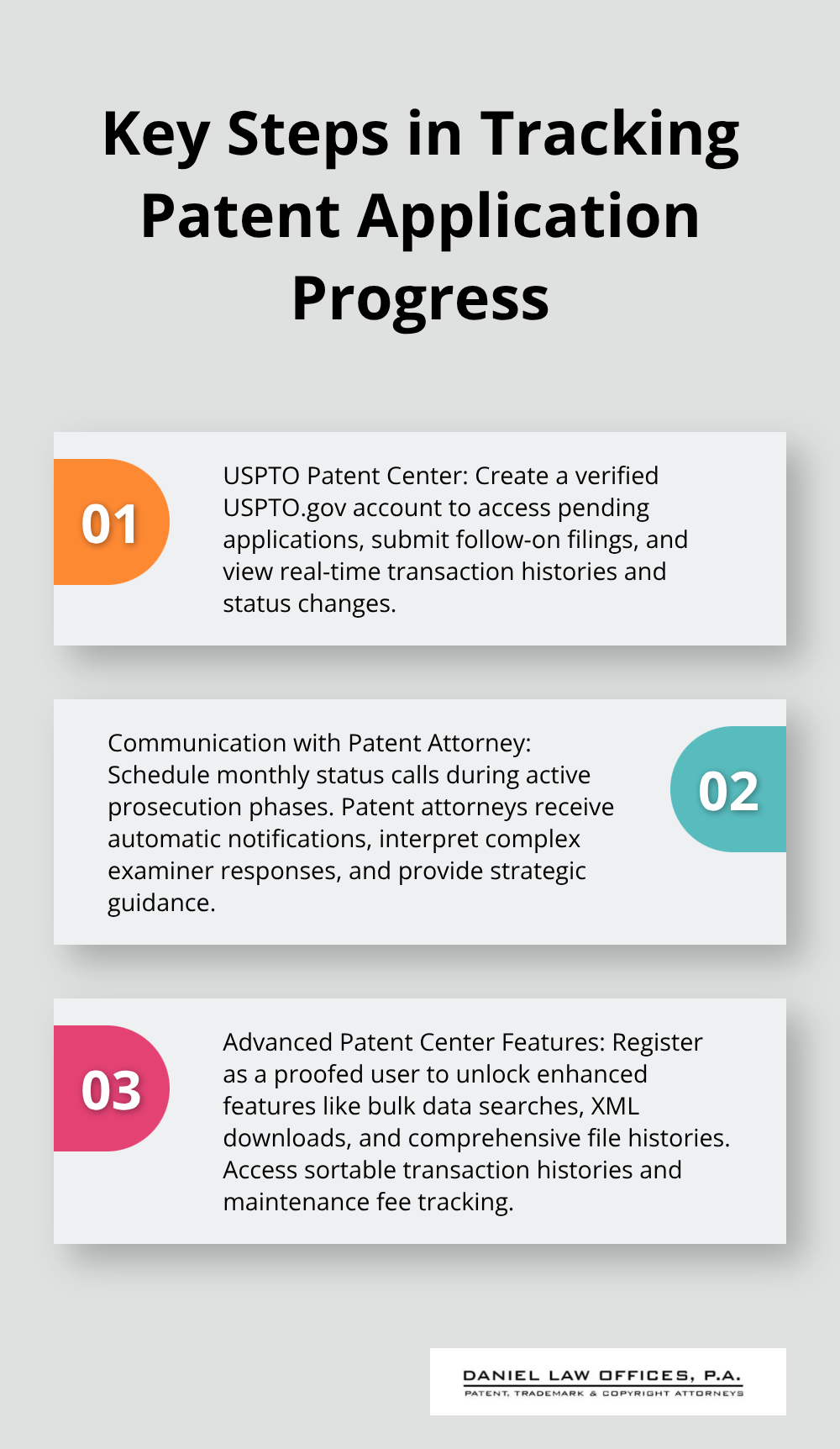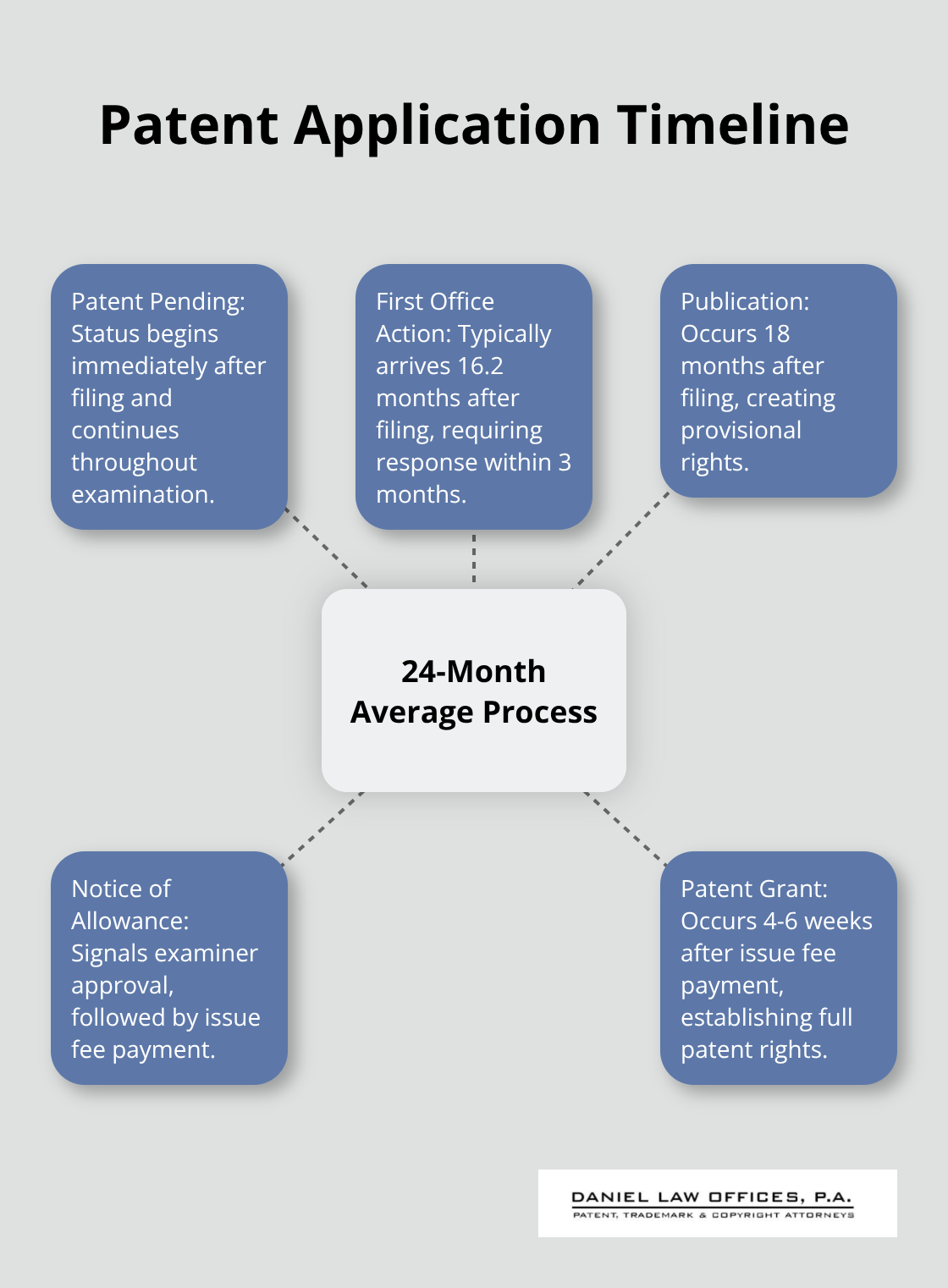How to Check Your Patent Filing Status in Orlando, Florida
Patent applications move through multiple stages before receiving approval, and tracking progress can feel overwhelming for inventors. At Daniel Law Offices, P.A., we help clients navigate the USPTO system effectively.
Monitoring your patent filing status regularly prevents missed deadlines and keeps your application on track. The USPTO provides several tools that make checking your application status straightforward and accessible.
What Patent Filing Status Reveals About Your Application
Patent filing status shows the current position of your application within the USPTO examination process. Each status update indicates specific actions that patent examiners take, responses that applicants must provide, or administrative milestones that the application reaches during prosecution. The USPTO Patent Center displays real-time status information that updates as your application moves through examination stages.
How USPTO Status Codes Work
The Patent Center uses specific status codes that correspond directly to examination activities. Application Filing Receipt confirms the USPTO received your submission and assigned an application number. First Office Action Pendency currently averages 16.2 months according to USPTO data, which means applicants typically wait over a year before they receive initial examiner feedback. Notice of Publication signals that your application will become publicly accessible 18 months after you file, regardless of examination completion.
Status Updates That Require Immediate Response
Office Action Mailed demands immediate attention because response deadlines typically allow only three months for replies. Applications that miss these deadlines face permanent abandonment. Notice of Allowance means your patent will issue after you pay required fees within three months. Maintenance fee reminders appear at 3.5, 7.5, and 11.5 years after patent grant – patent rights terminate when owners ignore these notifications. Application status changes trigger automatic email notifications for registered Patent Center users (eliminating the need for manual checks).
How Status Tracking Prevents Application Loss
Patent applications face abandonment when applicants miss response deadlines or fee payments. The USPTO reports that approximately 25% of applications become abandoned due to failure to respond to Office Actions within required timeframes. Regular status checks identify upcoming deadlines weeks in advance and provide sufficient time to prepare comprehensive responses. Patent Center users receive email alerts for status changes, but sole reliance on automated notifications creates risk if email delivery fails or accounts become inactive (making manual verification necessary).

The USPTO provides multiple methods to access this status information, each with distinct advantages for different user needs.
How Do You Track Your Patent Application Progress
The USPTO Patent Center serves as the primary gateway for patent application status checks and replaced the retired Public PAIR system in July 2022. Users create a verified USPTO.gov account to access pending applications and submit follow-on filings, while guest users search public patent applications without accounts. The Patent Center displays real-time transaction histories, document uploads, and status changes that update immediately when patent examiners act on applications. Users navigate to the Patent Center through the official USPTO website and enter application numbers (consisting of a two-digit series code followed by a six-digit serial number assigned during filing).
Direct Communication With Your Patent Attorney
Patent attorneys receive automatic notifications from the USPTO and monitor multiple applications simultaneously, which makes them more reliable than self-monitoring for critical deadlines. Contact your patent attorney immediately when status changes occur or deadlines approach, as legal professionals maintain privileged access to application details and prosecution strategies. Schedule monthly status calls with your attorney during active prosecution phases, particularly when First Office Action Pendency averages 16.2 months according to current USPTO data. Your attorney interprets complex examiner responses and provides strategic guidance that generic status updates cannot deliver.
Advanced Patent Center Features for Detailed Tracking
Users register as proofed users in the Patent Center to unlock enhanced features including bulk data searches, XML downloads, and comprehensive file histories that guest accounts cannot access. The system provides sortable transaction histories, document previews, and maintenance fee tracking that updates automatically when payments become due. Contact the Patent Electronic Business Center at 866-217-9197 for technical assistance with account verification or system navigation issues. The Patent Center also connects to Global Dossier services, which allows users to track related international applications through a single interface when they file PCT applications or foreign counterparts.

Understanding these tracking methods helps inventors recognize when their applications reach critical stages that require specific responses and actions.
What Status Updates Mean for Your Application
Patent applications produce specific status notifications that inventors must understand to maintain their rights. Patent Pending status begins immediately after you file and continues until the USPTO completes examination, which currently takes an average of 24 months from application to final disposition according to USPTO statistics. Applications remain in Patent Pending throughout the examination process, including during Office Action responses and examiner reviews. This status provides no indication of application strength or approval likelihood, but it allows inventors to mark products with patent pending notices for marketing purposes.
Office Actions Require Strategic Responses
Office Actions represent the most critical status updates inventors receive during prosecution. Non-Final Office Actions typically arrive 16.2 months after you file based on current USPTO First Office Action Pendency data, and applicants receive exactly three months to respond or face abandonment. Final Office Actions signal that examiners maintain rejections after they review applicant responses, which requires continuation applications or appeals to proceed further. Response quality matters significantly because poorly prepared responses often produce additional Office Actions that extend prosecution timelines and increase costs. Patent attorneys handle Office Action responses more effectively because examiner interview success rates exceed 80% when attorneys communicate directly with USPTO personnel.
Publication Creates Provisional Rights
Patent applications publish automatically 18 months after you file unless inventors file non-publication requests with domestic-only prosecution strategies. Publication creates provisional rights that allow patent owners to collect reasonable royalties from infringers after patents issue, but these rights remain unenforceable until actual grant occurs. Published applications become part of the public record and can serve as prior art against later applications (making early publication strategically important for competitive industries).
Grant Process Establishes Full Patent Rights
Notice of Allowance arrives when examiners approve applications, followed by Issue Fee Due notifications that require payment within three months to complete the patent grant process. Patents issue approximately 4-6 weeks after issue fee payment, which creates enforceable rights that last 20 years from the original filing date for utility patents. Patent owners must pay maintenance fees at 3.5, 7.5, and 11.5 years after grant to keep patents active (failure to pay these fees results in patent expiration and loss of all rights).

Final Thoughts
Regular patent filing status checks prevent costly mistakes that destroy years of development work. The USPTO reports that 25% of applications face abandonment due to missed deadlines, which makes consistent monitoring essential for intellectual property protection. Patent applications demand responses within strict three-month windows, and automated email notifications fail when accounts become inactive or email addresses change.
Professional legal assistance becomes necessary when Office Actions arrive, particularly because examiner interview success rates exceed 80% when attorneys handle communications directly. Patent attorneys interpret complex rejections and develop strategic responses that generic status updates cannot provide. We at Daniel Law Offices, P.A. guide inventors through the entire patent prosecution process and help secure valuable intellectual property protection for individual inventors and businesses throughout Orlando, Florida.
Establish monthly status checks during active prosecution phases and maintain current contact information in your Patent Center account. Schedule consultation calls with qualified patent attorneys when status changes occur, especially for Office Actions or Notice of Allowance notifications that require immediate action. These proactive steps preserve your patent rights and maximize the value of your intellectual property investment (which often represents years of research and development effort).

